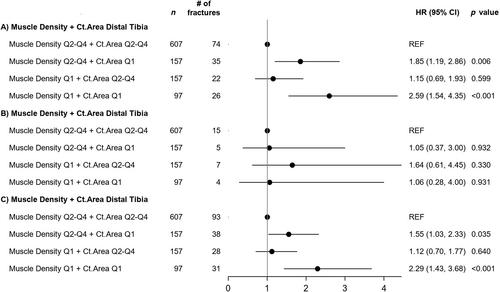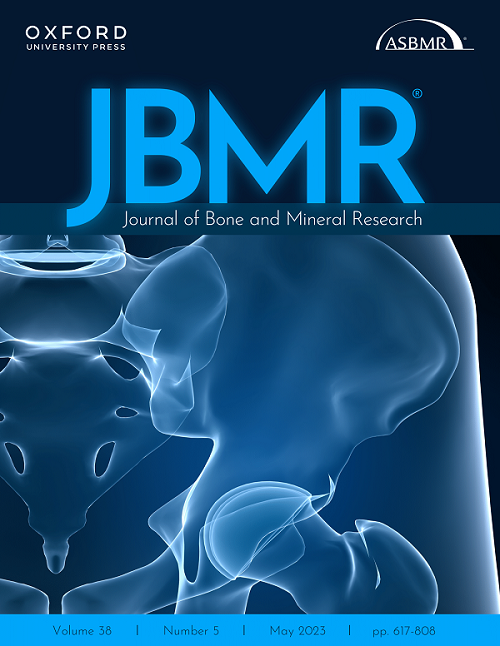Ben Kirk, Stephanie L Harrison, Jesse Zanker, Andrew J Burghardt, Eric Orwoll, Gustavo Duque, Peggy M Cawthon
下载PDF
{"title":"Interactions Between HR-pQCT Bone Density and D3Cr Muscle Mass (or HR-pQCT Bone Structure and HR-pQCT Muscle Density) in Predicting Fractures: The Osteoporotic Fractures in Men Study","authors":"Ben Kirk, Stephanie L Harrison, Jesse Zanker, Andrew J Burghardt, Eric Orwoll, Gustavo Duque, Peggy M Cawthon","doi":"10.1002/jbmr.4874","DOIUrl":null,"url":null,"abstract":"<p>We examined if an interaction exists between bone and muscle in predicting fractures in older men. Prospective data from the Osteoporotic Fractures in Men study was used to build Cox proportional hazards models. Predictors included HR-pQCT total volumetric BMD (Tt.BMD), trabecular BMD (Tb.BMD), cortical BMD (Ct.BMD) and cortical area (Ct.Ar) at distal radius/tibia, HR-pQCT muscle volume and density (diaphyseal tibia), D<sub>3</sub>-creatine dilution (D<sub>3</sub>Cr) muscle mass, and grip strength and leg force, analyzed as continuous variables and as quartiles. Incident fractures were self-reported every 4 months via questionnaires and centrally adjudicated by physician review of radiology reports. Potential confounders (demographics, comorbidities, lifestyle factors, etc.) were considered. A total of 1353 men (mean age 84.2 ± 4.0 years, 92.7% white) were followed for 6.03 ± 2.11 years. In the unadjusted (continuous) model, there were no interactions (<i>p</i> > 0.05) between any muscle variable (D<sub>3</sub>Cr muscle mass, muscle volume, muscle density, grip strength or leg force) and Tt.BMD at distal radius/tibia for fractures (all: <i>n</i> = 182–302; nonvertebral: <i>n</i> = 149–254; vertebral: <i>n</i> = 27–45). No consistent interactions were observed when interchanging Tt.BMD for Tb.BMD/Ct.BMD or for Ct.Ar (bone structure) at the distal radius/tibia in the unadjusted (continuous) models. Compared with men in quartiles (Q) 2–4 of D<sub>3</sub>Cr muscle mass and Q2–4 of distal tibia Tt.BMD, men in Q1 of both had increased risk for all fractures (hazard ratio (HR) = 2.00; 95% confidence interval [CI] 1.24–3.23, <i>p</i> = 0.005) and nonvertebral fractures (HR = 2.10; 95% CI 1.25–3.52, <i>p</i> < 0.001) in the multivariable-adjusted model. Confidence intervals overlapped (<i>p</i> > 0.05) when visually inspecting other quartile groups in the multivariable-adjusted model. In this prospective cohort study of older men, there was no consistent interactions between bone and muscle variables on fracture risk. Larger sample sizes and longer follow-up may be needed to clarify if there is an interaction between bone and muscle on fracture risk in men. © 2023 The Authors. <i>Journal of Bone and Mineral Research</i> published by Wiley Periodicals LLC on behalf of American Society for Bone and Mineral Research (ASBMR).</p>","PeriodicalId":185,"journal":{"name":"Journal of Bone and Mineral Research","volume":"38 9","pages":"1245-1257"},"PeriodicalIF":5.1000,"publicationDate":"2023-06-23","publicationTypes":"Journal Article","fieldsOfStudy":null,"isOpenAccess":false,"openAccessPdf":"https://onlinelibrary.wiley.com/doi/epdf/10.1002/jbmr.4874","citationCount":"0","resultStr":null,"platform":"Semanticscholar","paperid":null,"PeriodicalName":"Journal of Bone and Mineral Research","FirstCategoryId":"3","ListUrlMain":"https://onlinelibrary.wiley.com/doi/10.1002/jbmr.4874","RegionNum":1,"RegionCategory":"医学","ArticlePicture":[],"TitleCN":null,"AbstractTextCN":null,"PMCID":null,"EPubDate":"","PubModel":"","JCR":"Q1","JCRName":"ENDOCRINOLOGY & METABOLISM","Score":null,"Total":0}
引用次数: 0
引用
批量引用
Abstract
We examined if an interaction exists between bone and muscle in predicting fractures in older men. Prospective data from the Osteoporotic Fractures in Men study was used to build Cox proportional hazards models. Predictors included HR-pQCT total volumetric BMD (Tt.BMD), trabecular BMD (Tb.BMD), cortical BMD (Ct.BMD) and cortical area (Ct.Ar) at distal radius/tibia, HR-pQCT muscle volume and density (diaphyseal tibia), D3 -creatine dilution (D3 Cr) muscle mass, and grip strength and leg force, analyzed as continuous variables and as quartiles. Incident fractures were self-reported every 4 months via questionnaires and centrally adjudicated by physician review of radiology reports. Potential confounders (demographics, comorbidities, lifestyle factors, etc.) were considered. A total of 1353 men (mean age 84.2 ± 4.0 years, 92.7% white) were followed for 6.03 ± 2.11 years. In the unadjusted (continuous) model, there were no interactions (p > 0.05) between any muscle variable (D3 Cr muscle mass, muscle volume, muscle density, grip strength or leg force) and Tt.BMD at distal radius/tibia for fractures (all: n = 182–302; nonvertebral: n = 149–254; vertebral: n = 27–45). No consistent interactions were observed when interchanging Tt.BMD for Tb.BMD/Ct.BMD or for Ct.Ar (bone structure) at the distal radius/tibia in the unadjusted (continuous) models. Compared with men in quartiles (Q) 2–4 of D3 Cr muscle mass and Q2–4 of distal tibia Tt.BMD, men in Q1 of both had increased risk for all fractures (hazard ratio (HR) = 2.00; 95% confidence interval [CI] 1.24–3.23, p = 0.005) and nonvertebral fractures (HR = 2.10; 95% CI 1.25–3.52, p < 0.001) in the multivariable-adjusted model. Confidence intervals overlapped (p > 0.05) when visually inspecting other quartile groups in the multivariable-adjusted model. In this prospective cohort study of older men, there was no consistent interactions between bone and muscle variables on fracture risk. Larger sample sizes and longer follow-up may be needed to clarify if there is an interaction between bone and muscle on fracture risk in men. © 2023 The Authors. Journal of Bone and Mineral Research published by Wiley Periodicals LLC on behalf of American Society for Bone and Mineral Research (ASBMR).
HR-pQCT骨密度和D3Cr肌肉质量(或HR-pQCT-Bone Structure和HR-pQCT-Muscle Density)在预测骨折中的相互作用:男性骨质疏松性骨折研究
我们研究了在预测老年男性骨折时,骨骼和肌肉之间是否存在相互作用。来自男性骨质疏松性骨折研究的前瞻性数据用于建立Cox比例风险模型。预测因素包括HR pQCT总体积BMD(Tt.BMD)、小梁BMD(Tb.BMD)、桡骨远端/胫骨处的皮质BMD(Ct.骨密度)和皮质面积(Ct.Ar)、HR pQCT肌肉体积和密度(胫骨骨干)、D3肌酸稀释度(D3Cr)肌肉质量以及握力和腿部力量,作为连续变量和四分位数进行分析。骨折事件每4次自我报告 月,并由医生对放射学报告的审查进行集中裁决。考虑了潜在的混杂因素(人口统计学、合并症、生活方式因素等)。共有1353名男性(平均年龄84.2岁) ± 4 年,92.7%为白人)随访6.03 ± 2.11 年。在未调整(连续)模型中,没有相互作用(p >; 0.05)在任何肌肉变量(D3Cr肌肉质量、肌肉体积、肌肉密度、握力或腿部力量)和桡骨/胫骨远端骨折的Tt.BMD之间(所有:n = 182–302;非椎骨:n = 149–254;脊椎:n = 27-45)。在未调整(连续)模型中,将Tt.BMD与Tb.BMD/Ct.BMD或桡骨远端/胫骨处的Ct.Ar(骨结构)互换时,未观察到一致的相互作用。与D3Cr肌肉质量四分位数(Q)2-4和胫骨远端Tt.BMD四分位数Q2-4的男性相比,第一季度和第二季度的男性发生所有骨折的风险都增加了(风险比(HR)= 2.00;95%置信区间[CI]1.24–3.23,p = 0.005)和非椎骨骨折(HR = 2.10;95%置信区间1.25–3.52,p <; 0.001)。置信区间重叠(p >; 0.05)。在这项针对老年男性的前瞻性队列研究中,骨骼和肌肉变量之间对骨折风险的相互作用并不一致。可能需要更大的样本量和更长的随访时间来澄清骨骼和肌肉之间是否存在对男性骨折风险的相互作用。©2023作者。由Wiley Periodicals LLC代表美国骨与矿物研究学会(ASBMR)出版的《骨与矿产研究杂志》。
本文章由计算机程序翻译,如有差异,请以英文原文为准。


 求助内容:
求助内容: 应助结果提醒方式:
应助结果提醒方式:


